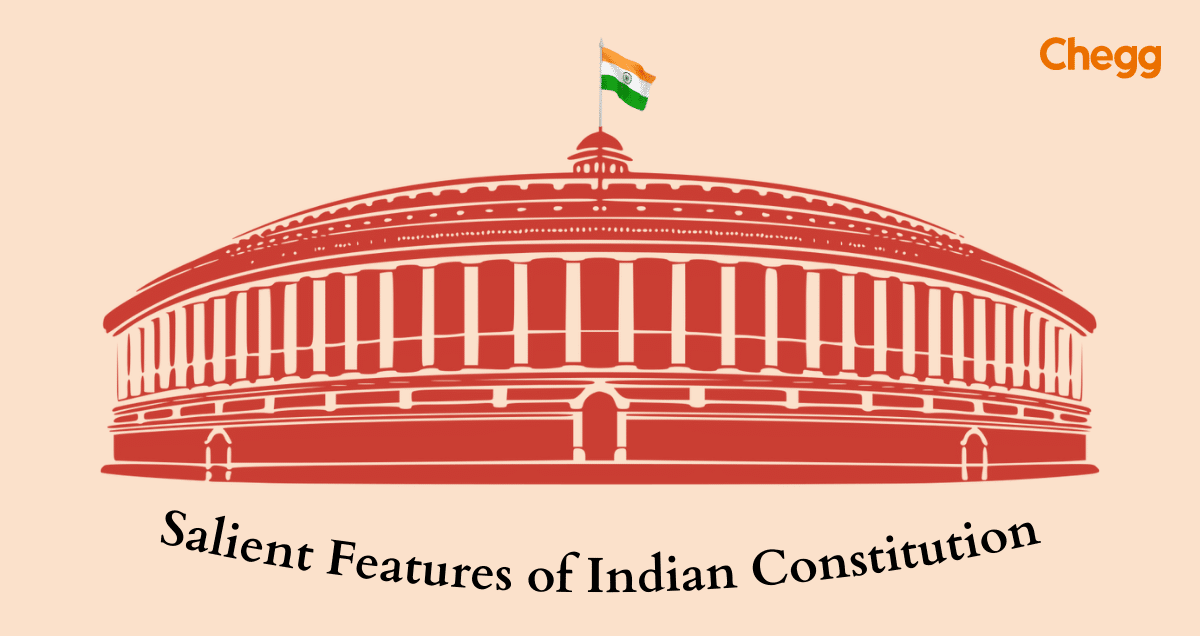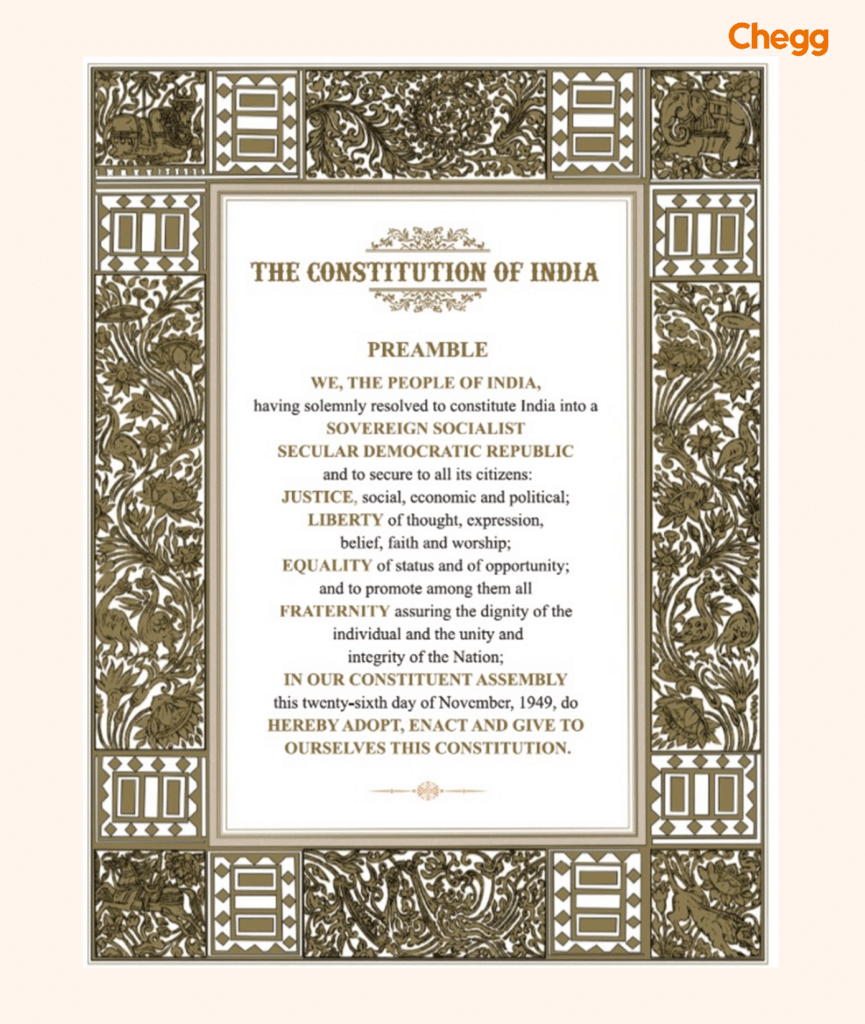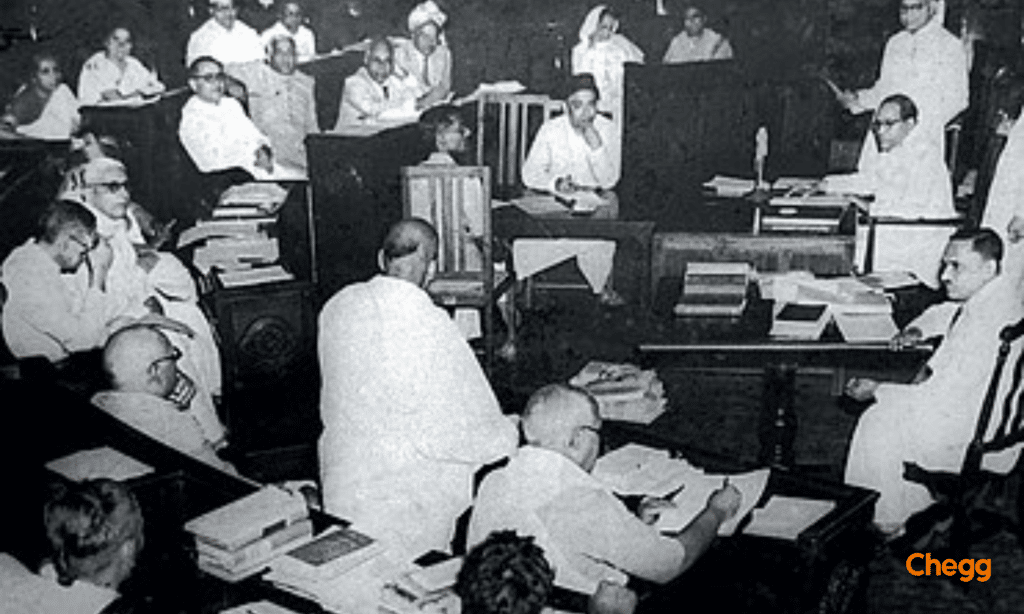
Quick Summary
The Indian Constitution is the supreme law of India, providing a framework for governance with these key features:
Adopted: November 26, 1949
Enacted: January 26, 1950
Table of Contents
Salient Features of Indian Constitution: The Indian Constitution establishes the foundation for a unified and democratic India. The document opens with a significant section known as the Preamble. This introductory passage serves a vital purpose by outlining the Constitution’s core principles and aspirations. These goals, in turn, profoundly influence the various features that make up the body of the Constitution.
Following the guiding light of the Preamble, the Constitution incorporates a number of key features designed to promote national unity, which are often referred to as the salient features of Indian constitution. One such feature is federalism, a system that balances the powers of the central government with those of individual states. This ensures that regional needs and concerns are addressed while maintaining a strong central authority. Another important feature is the concept of a supreme Constitution. This establishes the Constitution as the highest law of the land, ensuring that all other laws and actions comply with its principles.
The written nature of the Constitution is another key feature, often highlighted as one of the salient features of Indian constitution. Having a clear and documented set of rules provides transparency and stability. Additionally, the Constitution is designed to be relatively rigid, with a specific amendment process. This helps to ensure that the core principles of the document are not easily altered, fostering long-term stability.

The Indian Constitution serves as the supreme law of the land and is one of the key salient features of Indian constitution. It acts as a blueprint for India’s political system, outlining the responsibilities and powers of government institutions. It also safeguards the fundamental rights of citizens and establishes the core principles that guide governance.
The Indian Constitution, known for its extensive detail and often discussed in the context of the salient features of Indian constitution is structured into several key components:
Also Read:- Preamble of Indian Constitution | A Brief Overview
The Indian Constitution, which establishes the structure, procedures, powers, and duties of government institutions as well as fundamental rights, guiding principles of state policy, and citizen duties, is the ultimate law of the land. It also lays out the framework defining fundamental political principles. This is the entire list of the salient features of Indian constitution:
Here is a list of 15 salient features of Indian constitution
Several factors contributed to its length:
| Source | Features Included |
|---|---|
| Government of India Act 1935 | Office of the Governor, Emergency Provisions, Public Service Commission |
| British Constitution | Parliamentary System, Rule of Law, Single Citizenship, Bicameral Legislature |
| U.S. Constitution | Fundamental Rights, Judicial Review, Presidential Impeachment, Vice President Role, Removal of Judges |
| Irish Constitution | Directive Principles of State Policy, Presidential Election Method, Rajya Sabha Nominations |
| Canadian Constitution | Quasi-Federal Structure, Central Government’s Role in State Governor Appointments, Supreme Court Advisory Jurisdiction |
| German Constitution | Fundamental Rights Supervision during Emergencies |
| Australian Constitution | Concurrent Legislative Powers, Joint Parliamentary Sessions, Freedom of Trade and Commerce |
| Russian Constitution | Fundamental Duties, Social Justice Principles in the Preamble |
| French Constitution | Republic, Liberty, Equality, and Fraternity Principles in the Preamble |
| South African Constitution | Constitutional Amendment Procedures, Rajya Sabha Member Elections |
| Japanese Constitution | Law Establishment Procedures |
This table outlines the federal and unitary Salient Features of Indian Constitution:
| Federal Features | Unitary Features |
|---|---|
| Division of powers between the Centre and states | Strong central authority with more power to the Centre |
| Existence of both state and central governments | The ability of the Centre to legislate for states during emergencies |
| Provision for All India Services | Absence of separate state services, promoting central dominance |
| Written constitution outlining laws and principles | Independent judiciary ensures justice |
| The dominance of the Centre in a federal structure | Emergency provisions allowing central control over states |
| Supremacy of the Constitution | Flexibility allows easier amendments in certain cases |
| Provision of single citizenship | Unitary bias in the distribution of powers |
| Rigidity in the amendment process for federal laws | A single constitution governing the entire nation |
| Independent judiciary ensuring justice | Integrated judiciary for uniform interpretation of laws |
| Presence of bicameral legislature (Lok Sabha and Rajya Sabha) | Centralized control over legislative processes during emergencies |
Also Read:- The 44th Amendment of the Indian Constitution: An Overview
The Indian Constitution, which embodies many salient features of Indian constitution establishes a strong foundation for a well-functioning democracy through several key principles:
There are a total of 12 schedules of the Indian Constitution, which are among the salient features of Indian Constitution. The breakdown of the 12 schedules is as follows:
| Schedule | Description |
|---|---|
| First Schedule | Lists the names of states and union territories along with their territories. |
| Second Schedule | Provides provisions related to the allowances, privileges, etc., of the president, governors, and speakers of both houses. |
| Third Schedule | Outlines the oaths and affirmations for elected officials and others. |
| Fourth Schedule | Assigns Rajya Sabha seats for each state and union territory. |
| Fifth Schedule | Relates to administering minority communities in Scheduled Areas and Tribes in specific states. |
| Sixth Schedule | Administers tribal areas in states like Assam, Meghalaya, Tripura, and Mizoram. |
| Seventh Schedule | Divides legislative subjects into three lists: Union, State, and Concurrent. |
| Eighth Schedule | Lists 22 official languages recognized by the Constitution. |
| Ninth Schedule | Involves state acts and regulations related to land reforms and eliminating the zamindari system. |
| Tenth Schedule | Discusses disqualification of elected members based on defection. |
| Eleventh Schedule | Includes provisions relating to the powers and roles of panchayats. |
| Twelfth Schedule | Deals with the powers and roles of municipalities. |
| Parts | Subject Matter |
|---|---|
| I | The Union and its Territory |
| II | Citizenship |
| III | Fundamental Rights |
| IV | Directive Principles of State Policy |
| IV-A | Fundamental Duties |
| V | The Union Government |
| VI | The State Governments |
| VIII | The Union Territories |
| IX | The Panchayats |
| IX-A | The Municipalities |
| IX-B | The Co-operative Societies |
| X | The Scheduled and Tribal Areas |
| XI | Relations between the Union and the States |
| XII | Finance, Property, Contracts, and Suits |
| XIII | Temporary, Transitional, and Special Provisions |
| XIV | Services under the Union and the States |
| XIV-A | Tribunals |
| XV | Elections |
| XVI | Special Provisions relating to certain Classes |
| XVII | Official Languages |
| XVIII | Emergency Provisions |
| XIX | Miscellaneous |
| XX | Amendment of the Constitution |
| XXI | Temporary, Transitional and Special Provisions |
| XXII | Short title, Commencement, Authoritative Text in Hindi, and Repeals |

The salient features of Indian constitution were primarily shaped by the visionary scholar Dr. B.R. Ambedkar. However, several remarkable leaders like Jawaharlal Nehru shared a deep vision for post-independence India and made vital contributions to the salient features of Indian constitution. Another influential figure, Sardar Patel, contributed administrative expertise in uniting princely states.
Also Read:-
The Right Against Exploitation: Articles 23 and 24
Amendment of Indian Constitution
Schedules of Indian Constitution
List of Chief Justice of India (1950-2024)
25 Parts of Indian Constitution
National Parties in India: Impact on Governance
105 Amendment of Indian Constitution: An Overview
Constituent Assembly of India: An Overview
Salient Features of Indian Constitution reflect the nation’s core values and goals. The Constitution’s balance of powers between all three organs helps keep the functions separate. This is to avoid any wrongs committed to the citizens and to care about their freedoms. This perspective shows how well it works for a fair and equal society. Overall, the salient features of Indian Constitution create a framework that not only reflects the nation’s core values but also strives to ensure a fair, just, and equal society through a well-balanced and accountable governance structure.
The Constitution is regarded as having a unitary spirit and being federal, which are key salient features of Indian constitution. A codified, supreme constitution, a three-tiered political system (local, state, and federal), bicameralism, the division of powers, and an independent judiciary are among its federation-like characteristics.
The Indian Constitution is the world’s longest, featuring a federal system with strong central elements, parliamentary democracy, fundamental rights, and directive principles for social welfare.
Here are a few ways to remember salient features of Indian Constitution:
Structure: Think “SUPREME” – Supreme Law, Union & States (federal), Parliamentary Democracy, Republic, Enduring Features (difficult to amend), Mmixed Government (borrows from both federal and unitary systems), Elections.
Content: Remember “FRDP” – Fundamental Rights (guaranteed freedoms), Directive Principles (aspirations for governance), Parliamentary System.
A federal structure of governance is established under the Indian Constitution, which is one of the key salient features of Indian constitution. It has every characteristic of a federation, including two governments, bicameralism, written constitutions, power division, supremacy of the constitution, and strict adherence to the Constitution.
Equal Rights (Articles 14–18) The right to equality guarantees that everyone is treated equally before the law, forbids discrimination based on any number of factors, treats all applicants for public jobs equally, and does away with untouchability and titles (such as Sir, Rai Bahadur, etc.).
A state is characterized by four main features: population, territory, government, and sovereignty. These elements define its structure and authority.

Authored by, Amay Mathur | Senior Editor




Amay Mathur is a business news reporter at Chegg.com. He previously worked for PCMag, Business Insider, The Messenger, and ZDNET as a reporter and copyeditor. His areas of coverage encompass tech, business, strategy, finance, and even space. He is a Columbia University graduate.
Editor's Recommendations
Chegg India does not ask for money to offer any opportunity with the company. We request you to be vigilant before sharing your personal and financial information with any third party. Beware of fraudulent activities claiming affiliation with our company and promising monetary rewards or benefits. Chegg India shall not be responsible for any losses resulting from such activities.
Chegg India does not ask for money to offer any opportunity with the company. We request you to be vigilant before sharing your personal and financial information with any third party. Beware of fraudulent activities claiming affiliation with our company and promising monetary rewards or benefits. Chegg India shall not be responsible for any losses resulting from such activities.